A technique is described where an atmospheric pressure-thermal desorption (AP-TD) device and electrospray ionization (ESI)-mass spectrometry (MS) are coupled and used for the rapid analysis of Bacillus subtilis spores in complex matrices. The resulting AP-TD/ESI-MS technique combines the generation of volatile compounds and/or pyrolysis products with soft-ionization MS detection. In the AP-TD/ESI-MS approach, an electrospray solvent plume was used as the ionization vehicle of thermally desorbed neutrals at atmospheric pressure prior to mass spectrometric analysis using a quadrupole ion trap mass spectrometer. The approach is quantitative with the volatile standard dimethyl methylphosphonate (DMMP) and with the use of an internal standard (diethyl methylphosphonate, DEMP). A linear response was obtained as tested in the 1–50 ppm range (R2 = 0.991) with a standard error of the estimate of 0.193 (0.9% RSD, n = 5). Bacterial spores were detected by performing pyrolysis in situ methylation with the reagent tetramethylammonium hydroxide (TMAH) for the detection of the bacterial spore biomarker dipicolinic acid (DPA) as the dimethylated derivative (2Me-DPA). This approach allowed spore detection even in the presence of growth media in crude lyophilized samples. Repetitive analyses could be performed with a duty cycle of less than 5 min total analysis time (including sample loading, heating and data acquisition). This strategy proved successful over other direct ambient MS approaches like DESI-MS and AP-TD/ESI-MS without the in situ derivatization step to detect the dipicolinic acid biomarker from spores. A detection limit for the dimethylated DPA biomarker was estimated at 1 ppm (equivalent to 0.01 μg of DPA deposited in the thermal desorption tube), which corresponded to a calculated detection limit of 105 spores deposited or 0.1% by weight spore composition in solid samples (assuming a 1 mg sample size). The AP-TD/ESI source used in conjunction with the in situ methylation step allowed the differentiation of bacterial spores from other ‘suspicious white powders’ using a single stage for mass analysis and with minimum sample preparation, making this approach suitable for simple field-portable MS instrumentation and pattern recognition data analysis.

You have access to this article
 Please wait while we load your content...
Something went wrong. Try again?
Please wait while we load your content...
Something went wrong. Try again?


 Please wait while we load your content...
Please wait while we load your content...